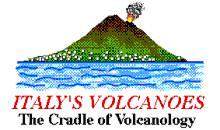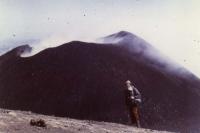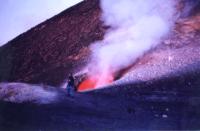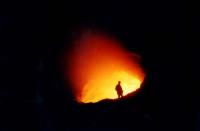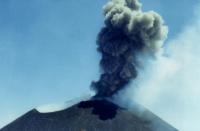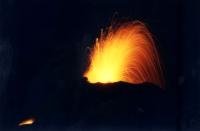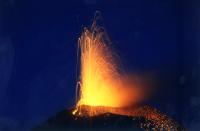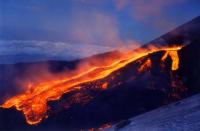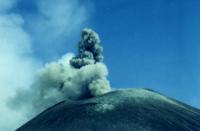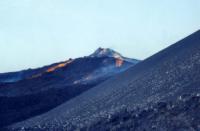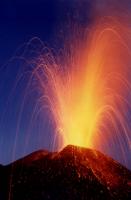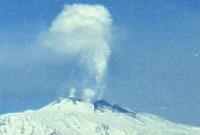| Etna
index |
||
| Geology | Geological history | Cones and craters |
| Eruptive characteristics | Eruptions before 1971 | Eruptions since 1971 |
| Etna and Man | References | Web sites |
| Weather forecasts | FAQ | Latest news |
The
1955-1971 summit eruptions, Part 3
1966-1971:
NE Crater activity and birth of Bocca Nuova
After 18 months of relative quiet in Etna's summit area
the NE Crater returned to life on 10 January 1966 with a series of non-magmatic
explosions that cleared its vent from debris which were followed on the
next day by Strombolian activity. On 13 January lava had risen within
the crater to its lip and began to spill over the W rim of the crater
to give a sluggish flow that extended several hundred meters towards NW.
With this the crater had returned to the conditions of its characteristic
persistent activity, which would make it become the most famous example
of this type in the next few years. There was little difference in this
activity as compared of the periods of activity between 1955 and 1964:
mild explosive (Strombolian) activity at the main vent of the crater was
accompanied by slow lava effusion, mostly from vents that were located
on the slopes and/or base of the pyroclastic cone which was growing around
the crater. In fact the first overflow of lava from the crater itself,
initiated on 13 January 1966, lasted little more than two days, then magma
broke through the NE base of the cone where a long-lived effusive vent
became active, delivering lava flows to the N, NE and E. Lavas produced
during the first half of 1966 usually extended less than 1.5 km from their
source vent, but on a few occasions lava flows reached lengths of up to
2.5 km.
From early June on, effusive activity not only occurred at the vent at the NE base of the NE Crater cone, but there was also sporadic effusive activity from vents at its N base; however, when these other vents produced lava, the output of the main vent diminished. A slight trend towards an intensification at the N vents and a diminution of the NE vent activity was observed at the end of the year.
No significant changes in the activity occurred during 1967. The only notable reported detail regarding the NE Crater in that year is that its cone reached an elevation of about 3247 m (Guest, 1973). Furthermore it appears that the main effusive vent at the NE base of the NE Crater cone remained active for most, if not all of, 1967. Lavas extended mainly to the N, NE and E, to distances of a few kilometers from the vent. The last days of that year saw a diminution of the activity at the NE Crater, and lava outflow temporarily ceased during the night of 27-28 December. However, the year 1968 was to bring some notable changes in addition to the relatively monotonous NE Crater activity.
Minor, short-lived lava emission from a vent on the E base of the NE Crater cone occurred on 1 January 1968, followed three days later by a recrudescence of explosive activity, which intensified during the next few days. This activity heralded the opening of an effusive vent about 2 km ESE from the NE Crater, near the Serra Giannicola Piccola, at an elevation of about 2500 m, on the morning of 7 January. Lava emitted from this vent - apparently it produced absolutely no explosive activity - rapidly spilled downslope towards the floor of the Valle del Bove, covering a distance of 1 km in a few hours. Later that day the flow reached the W base of the Monti Centenari, a twin cone formed in 1852-1853, about 1.8 km from the new effusive vent. During the following days lava emission continued, and lava accumulated at the base of the Monti Centenari, but the lava front extended only slowly, to stagnate after reaching about 1650 m elevation. After 15 January, the upper part of the lava flow had entirely crusted over, and lava was flowing through a tube. Rather than extending much further downslope, the new lava field extended laterally and in thickness by the emplacement of successive flow lobes on top of each other. On 24 January a new lava flow broke out from the S part of the main lava flow field, extending to the S of the Monti Centenari to about 1700 m elevation. During the activity of the new effusive vent, Strombolian activity from the NE Crater continued without significant variations.
During the first days of February, the outflow of lava from the vent on the W wall of the Valle del Bove continued. Most of the lava covered previous lavas, with no major flow lobes extending much beyond the margins of the flow field. From 10 February on, new lava lobes extended from the main flow field, which ran down to an elevation of about 1950 m. Lava also began to issue from numerous ephemeral vents on the main lava flow field. Another temporal increase in the effusion rate occurred on 24 February, and lava again extended as far as the W side of the Monti Centenari. Towards the end of the month, the effusion rate decreased, but lava fed by ephemeral vents extended to about 1800 m elevation to the W and N of the Monti Centenari.
The effusive activity - which was constantly accompanied by the usual persistent Strombolian activity at the NE Crater - continued through March, with some fluctuations similar to those observed during January and February. During the last week of March, new lava lobes spilled down to the S of the Monti Centenari and thus extended almost as far as the longest flows of January. During April the activity continued without significant variations, and the lava flow field grew mainly on its N side.
On 24 April a considerable increase in the effusion rate at the effusive vent of 7 January was accompanied by the opening of another effusive vent about half way between the 7 January vent and the NE Crater, at about 2900 m elevation. The flow produced by this vent was very small and extended only 250 m from the vent during the first 13 hours of activity. Concomitantly the NE Crater maintained its mild Strombolian activity. On the next day, both effusive vents were much less active, and the new vent at 2900 m elevation stopped producing lava during the night of 25-26 April. The 7 January vent produced a final surge of lava on 26 April and then its output progressively decreased to cease altogether on 4 May.
No estimates for the volume of lava produced between 7 January and 4 May 1968 have ever been published, although Cucuzza Silvestri (1969) provided a detailed chronology of the events during that period. On the base of the relatively similar periods of effusive activity in 1964 and 1999, however, the mean effusion rate can be tentatively put at 1 m3 per second or slightly more, and thus a total volume of 5-10 x 106 m3 of lava appears a realistic, though conservative, value.
The emission of lava from an eruptive fissure located at quite some distance from the summit craters, the third and most significant such event since 1956, requires a brief discussion at this point. All three episodes of lava emission from small fractures high on the W wall of the Valle del Bove in 1956, 1964 and 1968 could well be interpreted as lateral eruptions, due to their location outside the immediate range of the summit craters. Other eruptions which have occurred at similar locations (such as that of 1908) have unanimously been treated as flank eruptions. Nonetheless I believe it is opportune to consider the 1956, 1964 and 1968 effusive episodes as too closely related to the summit eruptive activity to be true flank eruptions. While it is surely difficult, and possibly also useless, to make a neat distinction of summit and flank eruption in some cases, the activity of the entire period from 1955 until 1971 is considered one of pure summit eruptions by many modern authors, also because the effusive episodes of 1956, 1964 and 1968 were in no manner related to a cessation of the activity in the summit area, as most flank eruptions are.
For a few days after the end of the effusive activity, the NE Crater showed little eruptive activity, but vigorous explosive activity resumed on 8 May, accompanied by the formation of two new effusive vents on the E side of the NE Crater cone, at about 3000 m elevation. However, both the explosive and effusive activity were short-lived, and it was only on 13 May that more regular activity resumed with explosions and a minor overflow of lava from the NW lip of the NE Crater. Later that day a new effusive vent became active at the NNE base of the NE Crater cone, which produced a modest flow, and on the following day lava was extruded from a fissure on the NW flank of the cone. From 15 to 19 May, most lava was produced from the effusive vent at the NNE base of the cone, while new lava was produced from the NW effusive vent from 22 to 24 May.
Between 31 May and 9 June, practically no effusive and only weak explosive
activity occurred at the NE Crater, but on the latter date, a new effusive
vent became active on the W rim of the Valle del Leone, at about 2850
m elevation, which fed a vigorous lava flow; mild Strombolian activity
persisted at the NE Crater.
Sometime during the night of 9-10 June 1968, a significant event took place in the NW part of the Central Crater. At the W base of the large pyroclastic cone built in 1964 around the Voragine, a new vent suddenly opened, but this new vent - which was soon called "Bocca Nuova", the new mouth - did not produce any true eruptive activity, but it was the site of intense rhythmic gas emissions. The width of the Bocca Nuova was only about 6 m; during the night its conduit was seen to be brilliantly incandescent, either due to heating by gas, or by the reflection of magma at shallow depth. During the following months the activity from the Bocca Nuova continued in a strikingly regular manner and attracted many scientists as well as tourists.
Reporting on the eruptive activity during the second half of 1968 is
much less detailed than for the first six months of that year, but without
any doubt the NE Crater continued to be the site of its classical persistent
activity. No further outflows of lava occurred from any vents other than
those closely associated with the NE Crater. In 1969 this crater remained
in activity, and the only significant development appears to have been
the shift of the main focus of effusive activity from the NE base of the
cone to its W flank (as observed by Guest, 1973). The Bocca Nuova was
the site of violent blasts of hot magmatic gas, which became more powerful
during 1969 than they had been in 1968. Then, at an unknown date during
the winter of 1969-1970, the ground around the Bocca Nuova collapsed,
fortunately when there was no one nearby. Observations by a mountain guide
of a gray plume rising from the summit area in February 1970 were taken
by Guest (1973) as a possible indicator of the approximate date of collapse.
As a result of the collapse and its enlargement from a 6 m-wide vent to a pit crater about 100 m in diameter, the character of degassing from the Bocca Nuova changed notably. Where there had been regular gas blasts before the collapse, quiet fuming occurred, and there were no reports of incandescence within the pit. Guest (1973) interpreted the collapse as the result of magma migration from below the Bocca Nuova into a fissure towards SE, possibly related to fracturing under the main summit cone directed towards the site where the 1971 eruption was to break out (on the SE side of the main summit cone).
The only detailed description of activity from the NE Crater during 1970
- apart from the fact that this crater was active during all of that year
- is based on observations made by Guest (1973) during the month of July.
At that time explosive activity occurred from several vents within the
crater, some ejecting mainly lithic material, while others contained liquid
lava and produced Strombolian explosions. Lava issued from a cluster of
vents at the NE base of the NE Crater cone, at which hornitos had formed;
active lava flows moved mainly towards NW.
The latest significant event during the long period of persistent activity
of the NE Crater was the opening of an effusive vent which was located
between the NE Crater cone and the Voragine, during the winter of 1970-1971.
This vent produced lava flows that moved to the W and E, and some lava
cascaded into the Voragine, whose lip was at about the same elevation
as the S base of the NE Crater cone. This activity continued through March
1971, although virtually no details are known about this latest stage
of the long-lived 1966-1971 NE Crater eruption. In early April 1971 the
crater had become quiet, but on the 5th of that month, a spectacular eruption
broke out from new vents at the SE base of the main summit cone, the first
phase of a complex series of events which culminated with a flank eruption
in May-June - the first flank eruption since 1951.
The total volume of lava emitted from the NE Crater during the 5 years of virtually uninterrupted activity has been estimated at about 120 x 106 m3, based on an assumed mean effusion rate of 1 m3 per second.
Copyright © Boris Behncke, "Italy's Volcanoes: The Cradle of Volcanology"
